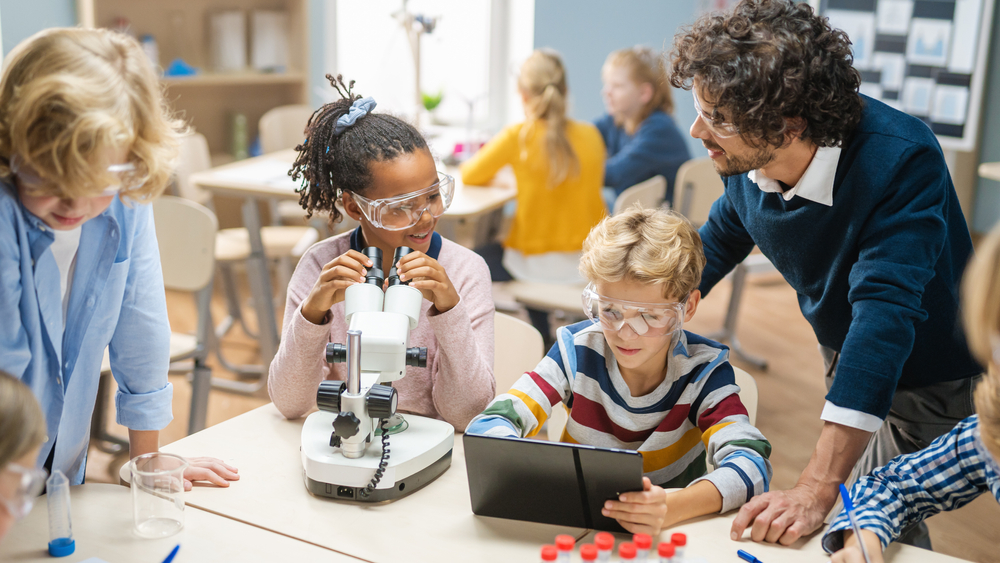The Importance of Scientific Investigation in Elementary School
- March 23, 2021
- By Justin Birckbichler

Throughout my K-12 schooling, one of my favorite science teachers was Mr. McCollough, my senior physics teacher. It wasn’t due to the fact that I had a profound love of physics (I didn’t) or the fact that he was also my cross-country coach (if I got in trouble during class, I had to run extra at practice, too). His rank of top dog in science was because of the amount of scientific investigations we did in his class.
As I transitioned into my own career as an educator, I couldn’t help but remember how much I loved his class. A few years ago, I took a part-time role as the science supervisor for elementary education and made it a mission to help promote integration of scientific investigations into classroom instruction. Here are three guiding principles that I share with teachers to help them understand the importance of scientific investigations.
Focus on the scientific inquiry process
Here’s a plot twist for you – not all scientific investigations have to tie directly into the content that you have to teach. I am not saying that standards aren’t important, but we often overlook the scientific inquiry process standards that are evident in many state and national standard sets in favor of drilling down on the “stuff” the students need to learn. While you may feel that it is absolutely imperative for students to understand that the mitochondria is the powerhouse of the cell, I can safely tell you that in my nearly three decades of life, that has never become a useful bit of information.
Instead, I find myself looking to the scientific method to solve many problems: noticing a problem/challenge, developing background understanding, designing a solution, manipulating variables, and analyzing my outcomes. Rinse and repeat as necessary.
You don’t have to take my word for it either. Cambridge University found that 93% of business leaders believe that “a demonstrated capacity to think critically, communicate clearly, and solve complex problems is more important than [a candidate’s] undergraduate major”.
Follow the 5E model
In 1987, a crack scientific unit was sent to Colorado retreat to develop a new model for elementary science and health. Today, we call their findings the 5E model of scientific investigation. If you have a scientific problem, if nothing else can help, and if you can find them…. maybe you can hire the Biological Sciences Curriculum Study (BSCS) team.
1980s action TV show reference aside, I do also understand that under our system of education, we are held to content standards as well. Yet nothing says we can’t do both scientific process and scientific learning at the same time. Consider using the BSCS team’s 5E model to accomplish just that:
- Engagement – students’ prior knowledge accessed and interest engaged in the phenomenon
- Exploration – students participate in an activity that facilitates conceptual change
- Explanation – students generate an explanation of the phenomenon
- Elaboration – students’ understanding of the phenomenon challenged and deepened through new experiences
- Evaluation – students assess their understanding of the phenomenon
Under this instructional model, students can experience an investigation and deepen their understanding of the required topic.
For example, when one of my fifth grade teachers had to teach about the concept of salinity, we did an entire investigation on comparing the density of salt water, fresh water, and a potato. We started by asking students what they knew about ocean water (engagement). We tested how the two types of water and potato interacted (exploration). The students worked in small groups to determine an explanation for why this may have happened. The teacher then facilitated a discussion to help take it further (elaboration). Finally, the students assessed how well they understood what salinity meant (evaluation).
The students developed a stronger understanding of salinity and were much more engaged than simply reading a textbook page about it.
When they can’t be hands on, be entertaining
Obviously, this school year has been different and we can’t do nearly as many hands on investigations due to COVID-19. Instead, we’ve pivoted to making scientific videos for students to view at home that follows the two above processes.
Taking the same salinity experience from earlier, I dressed up in a lab coat and performed the experiment. I walked the students through it step by step and tried to mimic an in-class experience as best as I could. You can check out the final video here.
If you watched the video, you’ll notice I had to put some tie cuts in there and made a few mistakes. I could have edited it out, but children love that sort of thing. There’s a reason Bill Nye is so popular and memorable – he combines entertainment and education. Don’t be afraid to show your goofy side off!
In a future post we’ll talk about structuring some investigations in more concrete terms, but it’s always important to start with a strong basis of “why and what” before we get to the “how”.